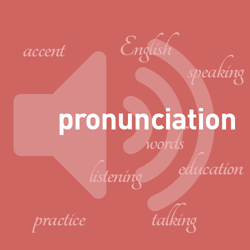Improving your accent by analysing a recording of your speech.
This is an exercise that can help improve your English pronunciation and reduce your accent. It involves developing a critical ear on your pronunciation of English.
Find 3 pieces of English spoken by native speakers. You may want to focus on speakers with the type of English accent you are looking to emulate. Try to choose 3 different types of speech e.g. one lecture, one colloquial conversation, one more formal conversation. It is important to choose 3 different speakers as one speaker may have a particular way in which they pronounce something which is not the general form of pronunciation for that accent. Choose a piece of speech that is at most 3 sentences in length. If you have difficulty in understanding spoken English fully then choose a source that has a transcript of what is said. A couple of good sources of spoken English are Youtube and BBC Learning English (for the British accent).
Listen to the passage and then record yourself saying it. When we speak, it is hard for us to hear exactly how we sound.
Listen back to both recordings and compare them. (If you want to look at your speech in more detail you can use free software such as Audacity to slow down the recordings). You will need to play each recording several times in order to fully ascertain the difference between the recordings. Consider the following points when listening to the recordings:
1. Vowels– are the vowel sounds the same in each of the words?
Are you using monophthongs where diphthongs are used by the speaker? Listen to the difference in vowel sounds between stressed and unstressed syllables – how does it compare with your recording?
2. Consonants– are the consonant sounds the same?
Are you fully saying the consonants at the end of words where the speaker is?
Are you missing out consonants where the speaker misses them out?
Do some of the consonant sounds the speaker says sound different to how they are written and how does that compare to your recording?
Does it sound like a consonant has been inserted in some places where it is not written, for example youngster can have a k inserted into it in connected speech, /jʌŋkstə/?
3. Word stress– are you stressing the same syllables in words?
Are you using the weak form of vowels in unstressed syllables?
4. Word linking– do some of the words the speaker says sound as if they are joined together? Is that the same in your recording?
Does the speaker insert a consonant between a vowel at the end of one word and the beginning of the next e.g. you /w/ offer?
When the same consonant appears at the end of one word and the beginning of the next, do you pronounce it once or twice? What does the speaker do?
Does the speaker join a consonant at the end of one word to vowel at the beginning of the next word?
5. Sentence rhythm and intonation – speech is a melody. If you were to hum the tune of the speaker’s speech would it be the same as the tune of your speech?
How does the speed of the two pieces of speech compare?
Are you pausing in the same place as the speaker?
Are you stressing the same words as the speaker?
Are the stressed words stressed to the same degree as the speaker?
Are you using the weak form of words where appropriate?
How does your pitch change in comparison with that of the speaker?
How does your range of pitch compare to that of the speaker?
How does your pitch move at the end of a speech unit and how does this compare to the speaker?
6. Voice placement (where you feel the vibration of your voice) and articulation – play around with where you place your voice. Does that impact on how similar you sound to the speaker? For example, if you project your voice further forward in the mouth or further back does it sound more or less like the speaker.
Play around with moving the jaw more or less, having the lips further back or forwards and resting the tongue in a different position in the mouth. How does that impact on how similar you sound to the speaker?
This is a good technique to use on an ongoing basis to work on your pronunciation. After working on three pieces of speech you may find that there are 2 or 3 areas that you have problems with and the other areas are generally fine, in which case when you use this technique in the future just focus on the questions for the areas you have difficulty with.
This exercise works purely on reading recorded transcripts, so at some point you will probably find it helpful to ask an English teacher to give you feedback on your pronunciation during spontaneous speech.
This article was written by pronunciationkaren.


 Clap
Clap
